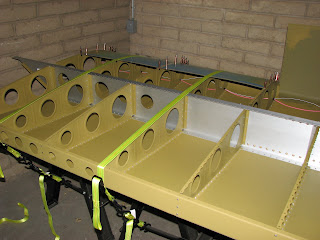It was quite an exiting day today. Besides installing the stall warner I also found a mistake I had made when riveting the nose ribs to the left spar. But let's start in chronological order.
I've assembled the stall warning subassembly and followed the instruction and the figures precisely. It was reported before that the washers used to position the vane in the center of the cutout of the center skin might not be thick enough. My stack of 5 washers measured .155" and as I had exactly the amount of washers that Van's mentioned in the manual I couldn't change this, so I went ahead and put the skin on to do the fine adjustment. Or so I wanted.
When I screwed the subassembly onto the rib I noticed that I could not turn the unit to adjust the vane position. The upper cutout in the base plate was a bit too narrow to allow the plate to move around the screw. So I took the subassembly off again, clamped it in the vise and filed the opening a bit wider. Back on the rib it proved to be usable now, so on with the skin and voila!
The vane was perfectly centered and almost perfectly adjusted as well. The fine adjustment is really tricky as most humans don't have arms long enough to get around both sides of the skin to manipulate the screw and the subassembly at the same time. While having x-ray vision to see through the upper part of the skin that blocks a view with ordinary eyes to see what you're doing. Somehow I managed to do all that without super-powers and I hope that tightening the screws after removing the skin did not change the adjustment or I will have to go through this again before riveting it on.
Wires installed and although I was afraid of having now connection to common ground because of all the primer I must have been lucky as the switch connected perfectly when agitated.

It was when I clecoed the skin on that I got to the most outboard rib where the center skins attaches to that I realized that this one didn't have a flange for the hole I was supposed to cleco. I went around it during the adjustment but then when the skin was removed I realized that I must have messed up the stack of ribs (again) when I prepared for the riveting. Somehow I got the one rib in there that is supposed to go onto the right side in the stiffener block at the root of the wing as this one has to have the nose flanges removed. The one I had put aside for this job was in the workshop and had the flanges!

The solution was simple but with the ribs installed maybe hard to do. I measured the room in between the ribs and yes, with the rivet removing tool in the chuck my shortest drill was too long to position on the rivets cleanly. Fortunately I had bought an angle drill a while back at HF and put it in storage (you can never have too many tools). This was now a real life saver!
I located the angle drill, put the remover tool on and voila! It fit easily between the ribs to get the job done.

This tool made it very easy as the tip positions the drill perfectly centered using the manufactured head to align the drill bit. You push the spinning drill bit down and the head goes flying. It helps to first push the mandrel all the way down by using a center punch a few times on each rivet. Once the head's gone, the shaft of the rivet can be pushed out with the center punch.

The rest was a cake walk! The correct rib clecoed in place and riveted on in minutes. The rivet removing tool is so gentle that you can hardly tell that the removed rib was actually used before.

Now, something like this better not happen on the 4 inboard ribs as they are so close that even an angle drill won't help you. You'd have to remove more than just one in that case. Also I'm not sure if the rivet remover would be so nice to use on the spar flanges for the ribs that are riveted to the angle tab AND the spar. The flange on the spar side is very narrow and I doubt this would have had such a nice happy ending like the one I had to repair.
So, the warning is: Double or triple check that you have the right rib in the right place before riveting!






















































